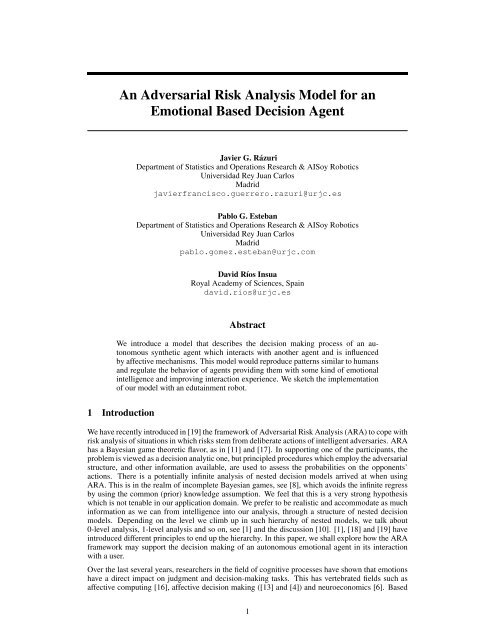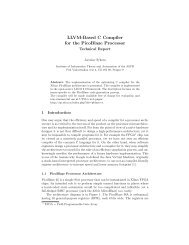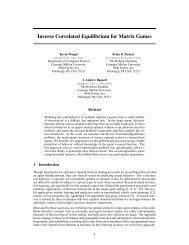decision making with multiple imperfect decision makers - Institute of ...
decision making with multiple imperfect decision makers - Institute of ...
decision making with multiple imperfect decision makers - Institute of ...
Create successful ePaper yourself
Turn your PDF publications into a flip-book with our unique Google optimized e-Paper software.
An Adversarial Risk Analysis Model for anEmotional Based Decision AgentJavier G. RázuriDepartment <strong>of</strong> Statistics and Operations Research & AISoy RoboticsUniversidad Rey Juan CarlosMadridjavierfrancisco.guerrero.razuri@urjc.esPablo G. EstebanDepartment <strong>of</strong> Statistics and Operations Research & AISoy RoboticsUniversidad Rey Juan CarlosMadridpablo.gomez.esteban@urjc.comDavid Ríos InsuaRoyal Academy <strong>of</strong> Sciences, Spaindavid.rios@urjc.esAbstractWe introduce a model that describes the <strong>decision</strong> <strong>making</strong> process <strong>of</strong> an autonomoussynthetic agent which interacts <strong>with</strong> another agent and is influencedby affective mechanisms. This model would reproduce patterns similar to humansand regulate the behavior <strong>of</strong> agents providing them <strong>with</strong> some kind <strong>of</strong> emotionalintelligence and improving interaction experience. We sketch the implementation<strong>of</strong> our model <strong>with</strong> an edutainment robot.1 IntroductionWe have recently introduced in [19] the framework <strong>of</strong> Adversarial Risk Analysis (ARA) to cope <strong>with</strong>risk analysis <strong>of</strong> situations in which risks stem from deliberate actions <strong>of</strong> intelligent adversaries. ARAhas a Bayesian game theoretic flavor, as in [11] and [17]. In supporting one <strong>of</strong> the participants, theproblem is viewed as a <strong>decision</strong> analytic one, but principled procedures which employ the adversarialstructure, and other information available, are used to assess the probabilities on the opponents’actions. There is a potentially infinite analysis <strong>of</strong> nested <strong>decision</strong> models arrived at when usingARA. This is in the realm <strong>of</strong> incomplete Bayesian games, see [8], which avoids the infinite regressby using the common (prior) knowledge assumption. We feel that this is a very strong hypothesiswhich is not tenable in our application domain. We prefer to be realistic and accommodate as muchinformation as we can from intelligence into our analysis, through a structure <strong>of</strong> nested <strong>decision</strong>models. Depending on the level we climb up in such hierarchy <strong>of</strong> nested models, we talk about0-level analysis, 1-level analysis and so on, see [1] and the discussion [10]. [1], [18] and [19] haveintroduced different principles to end up the hierarchy. In this paper, we shall explore how the ARAframework may support the <strong>decision</strong> <strong>making</strong> <strong>of</strong> an autonomous emotional agent in its interaction<strong>with</strong> a user.Over the last several years, researchers in the field <strong>of</strong> cognitive processes have shown that emotionshave a direct impact on judgment and <strong>decision</strong>-<strong>making</strong> tasks. This has vertebrated fields such asaffective computing [16], affective <strong>decision</strong> <strong>making</strong> ([13] and [4]) and neuroeconomics [6]. Based1







